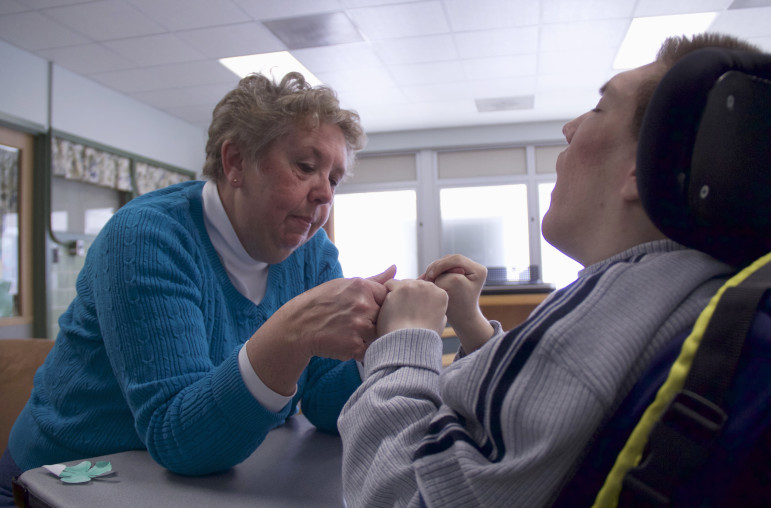State Ending Long-Term Institutional Care for Disabled?
Walker budget continues years-long trend, experts disagree on its impact.
Fighting to stay
About 200 people a year receive short-term medical care or intensive treatment programs at the state’s centers, before returning to live in the community. Bunck said community settings, which include a wide range of services, are “now the best and most common way for people with intellectual disabilities to receive long-term care.”
That care can be delivered in people’s homes, small and large residential care facilities or group homes and in nursing facilities.
But last year, at least one family went to court to ask that its child be protectively placed into long-term care at CWC. The family has petitioned Dane County juvenile court, according to the family’s attorney, and the child remains in short-term care while the case is pending.
Underwood’s husband, Kevin, described the case in a letter sent in January to DHS Secretary Kitty Rhoades. He said the state was ignoring the recommendation of the physician, who felt CWC offered the best therapeutic setting to meet the child’s complex medical needs.
“Our child’s situation at CWC is, simply put, finally humane,” a family member said in an email through the intermediary. CWC “starts by addressing the medical needs — for patients who require a facility level of care, comprehensive synchronized medical care from a multi-disciplinary staff.” Absent such care, “there is suffering.”
Other families, Underwood wrote, have given up trying to get their children into the facilities “due to their inability to engage in an expensive court battle with the state.” He argues that Wisconsin’s freeze on long-term care violates a federal rule requiring a choice between institutionalized care and home and community-based services.
“Having the right to choose is meaningless and lacks value,” Underwood wrote in a letter to the state last August. “Individuals in Wisconsin are being denied that choice even though facilities exist.”
But Brian Shoup, administrator of long-term care for DHS, wrote back that federal law does not require that institutional services be offered on an indefinite or extended basis.
“Rather, it requires the state Medicaid agency to provide choice between home and community-based services and institutional services,” Shoup wrote. He added that only a court can order placement in a state center, and then only if it is the most integrated and least restrictive setting appropriate to the person’s needs.
Quality of life
Rebecca Underwood insists that CWC qualifies under the least-restrictive standard, given her son’s intellectual disabilities and complex medical needs.
During a reporter’s visit in December, Aaron would not stop groaning. His mother massaged his back, rocked his wheelchair back and forth, and pushed it through the underground hallways that connect the buildings at CWC. This quieted him for a few moments, before he began groaning again.

Rebecca Underwood worries those like Aaron may not receive adequate support and care in the community. Photo: Feb. 25, 2015, Madison. Photo by Kate Golden / Wisconsin Center for Investigative Journalism.
“Existing and having a quality of life are two different things,” Underwood said. “When you have profound developmental disabilities coupled with medical fragility, that’s 365-day, 24/7 care they need.”
Natalie McClellan, whose son has lived at CWC for about 20 years, also does not see community placement as an option. Her son A.J., 30, was born with spina bifida, a birth defect that paralyzed him from the waist down. Because of another physical disability, he is fed through a tube. And a case of meningitis at the age of 5 left him with an intellectual disability that has complicated his physical disabilities.
“The bottom line for A.J. is his quality of life is completely dependent on how healthy he is,” McClellan said. She said her son has been healthier at CWC because of the quality, the consistency and coordination of care it provides, which is unavailable outside of the facility.
Underwood said that while CWC is not perfect, the facility has received awards for high standards and been used by the federal government to train inspectors.
In contrast, a state investigative report from 2007 documents a case in which an individual who was transferred out of CWC to a facility in New London was twice sent to an emergency room after a feeding tube came out. The person’s guardian was never told of these developments, violating a state rule, until the situation led to a two-week hospital stay.
There have also been problems in other states, including Texas, Virginia, Connecticut, New York and Louisiana.
In Georgia, at least 30 deinstitutionalized people died unexpectedly over a four-year period, a 2014 Atlanta Journal-Constitution investigation found. Individuals in community settings were punched, whipped with a belt, or denied medication and medical care. In one case, a prolonged failure to have a bowel movement caused a man to vomit blood, and die.
But attorney Hagopian of Disability Rights Wisconsin said people with serious developmental and physical disabilities have been successfully placed in Wisconsin communities for decades.
When Northern Wisconsin Center ended long-term care in 2006, he notes, the guardians of many residents believed it would be “impossible to provide safe and adequate health care” outside of the institution. In his view, “it wasn’t true then and it isn’t true now.”
When Northern Wisconsin Center ended long-term care in 2006, Hagopian notes, the guardians of many residents believed it would be “impossible to provide safe and adequate health care” outside of the institution. In his view, “it wasn’t true then and it isn’t true now.”
A survey found that guardians of Northern residents relocated to community living were generally satisfied. Seventy-eight percent felt their wards had opportunities to interact with the community. However, only about half said they were welcomed into it.
-
Wisconsin’s Medicaid Postpartum Protection Lags Most States
 Feb 27th, 2024 by Rachel Hale
Feb 27th, 2024 by Rachel Hale
-
Wisconsin Has A “Smart Growth” Law To Encourage Housing, But No One Is Enforcing It
 Dec 22nd, 2023 by Jonmaesha Beltran
Dec 22nd, 2023 by Jonmaesha Beltran
-
Milwaukee County Is Funding Affordable Housing In Suburbs
 Dec 21st, 2023 by Jonmaesha Beltran
Dec 21st, 2023 by Jonmaesha Beltran

















Well, I am still here to support people with intellectual disabilities. And as part of the community, I am actually in favor of the state’s plan for these individuals. Institutional facilities aren’t fully required to wholly take over for the long term care treatments for patients with developmental conditions. Home care is probably one of the best options.
Ellen S. Mattison
Coolidge Street Maitland, FL 32751